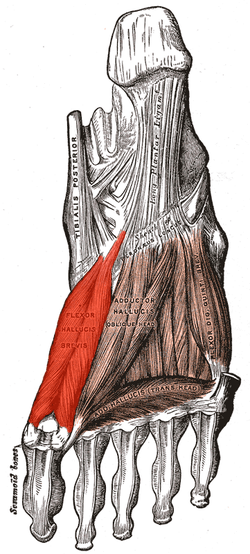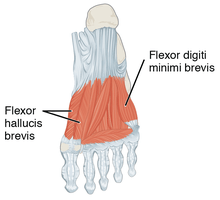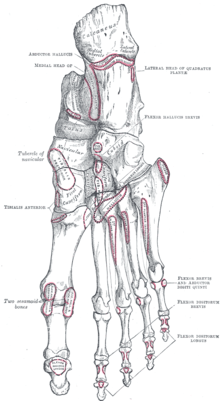Flexor hallucis brevis muscle
The Flexor hallucis brevis is a muscle of the foot that flexes the big toe.
| Flexor hallucis brevis muscle | |
|---|---|
 Muscles of the sole of the foot. Third layer. (Flexor hallucis brevis visible at left.) | |
| Details | |
| Origin | Plantar aspect of the cuneiformis, Plantar calcaneocuboid ligament, long plantar ligament |
| Insertion | Medial Head: Medial sesamoid bone of the metatarsophalangeal joint, proximal phalanx of great toe. Lateral head: Lateral sesamoid bone of the metatarsophalangeal joint, proximal phalanx of great toe |
| Nerve | medial plantar nerve |
| Actions | flex hallux |
| Antagonist | Extensor hallucis longus muscle |
| Identifiers | |
| Latin | musculus flexor hallucis brevis |
| TA | A04.7.02.057 |
| FMA | 37449 |
| Anatomical terms of muscle | |
Structure

It arises, by a pointed tendinous process, from the medial part of the under surface of the cuboid bone, from the contiguous portion of the third cuneiform, and from the prolongation of the tendon of the Tibialis posterior which is attached to that bone.
It divides in front into two portions, which are inserted into the medial and lateral sides of the base of the first phalanx of the great toe, a sesamoid bone being present in each tendon at its insertion.
The medial portion is blended with the Abductor hallucis previous to its insertion; the lateral portion (sometimes described as the first plantar interosseus) with the Adductor hallucis. The tendon of the Flexor hallucis longus lies in a groove between the two.
Innervation
The medial and lateral head of the flexor hallucis brevis is innervated by the medial plantar nerve. Both heads are represented by spinal segments S1, S2.
Function
Flexes the first metatarsophalangeal joint, or the big toe. Helps to maintain the medial longitudinal arch. Assists with the toe-off phase of gait providing increased push-off.
Additional images
| Wikimedia Commons has media related to Flexor hallucis brevis muscles. |
 Bones of the right foot. Plantar surface.
Bones of the right foot. Plantar surface.- Flexor hallucis brevis muscle
- Flexor hallucis brevis muscle
References
This article incorporates text in the public domain from page 493 of the 20th edition of Gray's Anatomy (1918)